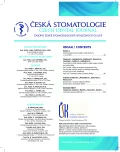Bioaerosol in the Dental Office
(Review)
Authors:
E. Sedlatá Jurásková 1; I. Matoušková 2
; I. Dubovská 1; Y. Morozova 1
Authors‘ workplace:
Klinika zubního lékařství LF UP a FN, Olomouc
1; Ústav preventivního lékařství LF UP, Olomouc
2
Published in:
Česká stomatologie / Praktické zubní lékařství, ročník 116, 2016, 4, s. 102-105
Overview
Background:
One of the possible way of transmission and spread of the infectious agents in the dental office is the airway (the air transmission). This is an indirect transmission of infectious agents. Bioaerosol generated during treatment of patients may affect the patient, dentist and also the sedimentation of bioaerosol on medical devices is possible. In our report we summarize all the knowledges and the risks of transmission of the infectious agents by bioaerosol.
Keywords:
bioaerosol – dental office – infectious agents
Sources
1. Cristina, M. L., Sapagnolo, A. M., Sartini, M., Dallera, M., Ottria, G.: Investigation of organizational and hygiene features in dentistry: a pilot study. J. Prev. Med. Hyg., roč. 50, 2009, č. 3, s. 175–180.
2. Ditommaso, S., Giacomuzzi, M., Ricciardi, E., Zotti, C. M.: Cultural and Molecular Evidence of Legionella spp. Colonization in Dental Unit Waterlines: Which Is the Best Method for Risk Assessment? Int. J. Environ. Res. Public Health., roč.13, 2016 Feb 6, č. 2, pii: E211. doi: 10.3390/ijerph13020211.
3. Dutil, S., Veillette, M., Mériaux, A., Lazure, L., Barbeau, J., Duchaine, C.: Aerosolization of mycobacteria and legionellae during dental treatment: low exposure despite dental unit contamination. Environ. Microbiol., roč. 9, 2007, č. 11, s. 2836–2843.
4. Dutil, S., Meriaux, A., de Latre moille, M. C., Lazure, L. et al.: Measurement of airborne bacteria and endotoxin generated during dental cleaning. J. Occup. Environ. Hyg., roč. 6, 2009, č. 2, s. 121–130.
5. Hallier, C., Williams, D. W., Potts, A. J., Lewis, M. A.: A pilot study of bioaerosol reduction using an air cleaning systemduring dental procedures. Br. Dent. J., roč. 209, 2010, č. 8, s. E14. Epub 2010 Oct 15.
6. Harrel, S. K., Molinari, J.: Aerosols and splatter in dentistry: A brief review of the literature and infection control implications. J. Am. Dent. Assoc., roč. 135, 2004, s. 429–437.
7. Chang, C. W., Li, S. Y., Huang, S. H., Huang, C. K., et al.: Effects of ultraviolet germicidal irradiation and swirling motion on airborne Staphylococcus aureus, Pseudomonas aeruginosa and Legionella pneumophila under various relative humidities. Indoor Air, roč. 23, 2012, s. 74–84.
8. Checchi, L., Montevecchi, M., Moreschi, A., Graziosi, F., et al.: Efficacy of three face masks in preventing inhalation of airborne contaminants in dental practice. J. Am. Dent. Assoc., roč. 136, 2005, s. 877–882.
9. Loster, B. W., Czesnikiewicz-Gizuk, M., Bielanski, W., Karczewska, E., et al.: Prevalence and characterization of Helicobacter pylori (H. pylori) infection and colonization in dentists. J. Physiol. Pharmacol., roč. 60, 2009, Suppl 8, s. 13–18.
10. Micik, R. E., Miller, R. L., Mazzarella, M. A., Ryge, G.: Studies on dental aerobiology, I: bacterial aerosols generated during dental procedures. J. Dent. Res., roč. 48, 1969, č. 1, s. 49–56.
11. Möller, W., Heimbeck, I., Hofer, T. P. J., Khadem Saba, G., et al.: Differential Inflammatory Response to Inhaled Lipopolysacharide Targeted Either to the Airways or the Alveoli in Man. PloS. ONE, roč. 7, č. 4, e33505. doi:10.1371/journal.pone.0033505.
12. Pankhurst, C. L., Coulter, W., Philpott-Howard, J. J., Harrison, T., Warburton, F., Platt, S., Surman. S., Challacombe, S.: Prevalence of legionella waterline contamination and Legionella pneumophila antibodies in general dental practitioners in London and rural Northern Ireland. Br. Dent. J., roč. 195, 2003, č. 10, s. 591–594.
13. Pitak-Arnnop, P., Schubert, S., Dhanuthai, K., Hemprich A.: Swine-origin H1N1 influenza A virus and dental practices: a critical review. Clin. Oral. Invest., roč. 14, 2010, s. 11–17.
14. Rautemaa, R., Norberg, A., Wuolijoki-Saaristo, K., Meurman, J. H.: Bacterial aerosols in dental practice - a potential hospital infection problem? J. Hosp. Infect., roč. 64, 2006, s. 76–81.
15. Ricci, M. L., Fontana, S., Pinci, F., Fiumana, E.: Pneumonia associated with dental unit waterline. Lancet, roč. 379, 2012, s. 684.
16. Szymaňska, J.: Dental bioaerosol as an occupational hazard in a dentist`s workplace. Ann. Agric. Environ. Med., roč. 14, 2007, s. 203–207.
17. Szymaňska, J., Dutkiewicz, J.: Concentration and species composition of aerobic and facultatively anaerobic bacteria released to the air of a dental operation area before and after disinfection of dental unit waterlines. Ann. Agric. Environ. Med., roč. 15, 2008, s. 301–307.
18. Timmerman, M. F., Menso, L., Steinfort, J., van Winkelhoff, A. J., van der Weijden, G.A.: Atmospheric contamination during ultrasonic scaling. J. Clin. Periodontol., roč. 31, 2004, s. 458–462.
19. Vyhláška 306/2012 Sb. o podmínkách předcházení vzniku a šíření infekčních onemocnění a o hygienických požadavcích na provoz zdravotnických zařízení a ústavů sociální péče.
20. Zdravotnická ročenka České republiky 2011. ÚZIS ČR, Praha 2012, s. 158.
21. 3MTM Chirurgické masky, respirátory a ochranné brýle. Propagační materiál 3M Health Care.
Labels
Maxillofacial surgery Orthodontics Dental medicineArticle was published in
Czech Dental Journal

2016 Issue 4
- What Effect Can Be Expected from Limosilactobacillus reuteri in Mucositis and Peri-Implantitis?
- The Importance of Limosilactobacillus reuteri in Administration to Diabetics with Gingivitis
Most read in this issue
-
Dry Socket and the Length of Healing Depending on the Type of the Treatment
Part two: Treatment with Ozonated Water
(Original Article – Clinical Study) -
Bioaerosol in the Dental Office
(Review)
